Rangemaster PLC: Comprehensive Ratio Analysis and Financial Report
VerifiedAdded on 2023/01/10
|9
|1965
|22
Report
AI Summary
This report presents a detailed financial analysis of Rangemaster PLC using ratio analysis, evaluating its performance and financial position. The introduction outlines the purpose and scope, followed by an analysis of profitability, liquidity, efficiency, and capital structure. Profitability ratios, including Return on Capital Employed (ROCE) and Return on Equity (ROE), are assessed to gauge management's efficiency and return generation. Liquidity ratios, such as the current and quick ratios, are examined to determine the company's ability to meet short-term obligations. Efficiency ratios, including inventory, debtor, and creditor days, are analyzed to assess operational efficiency and cash cycle. The capital structure is evaluated using the debt-equity ratio, and investor ratios, such as the P/E ratio, are considered. The analysis reveals Rangemaster's strong financial performance, highlighting efficient resource utilization, adequate returns, and a favorable financial position, with recommendations for continued sustainability and growth. The report concludes with references to supporting literature.
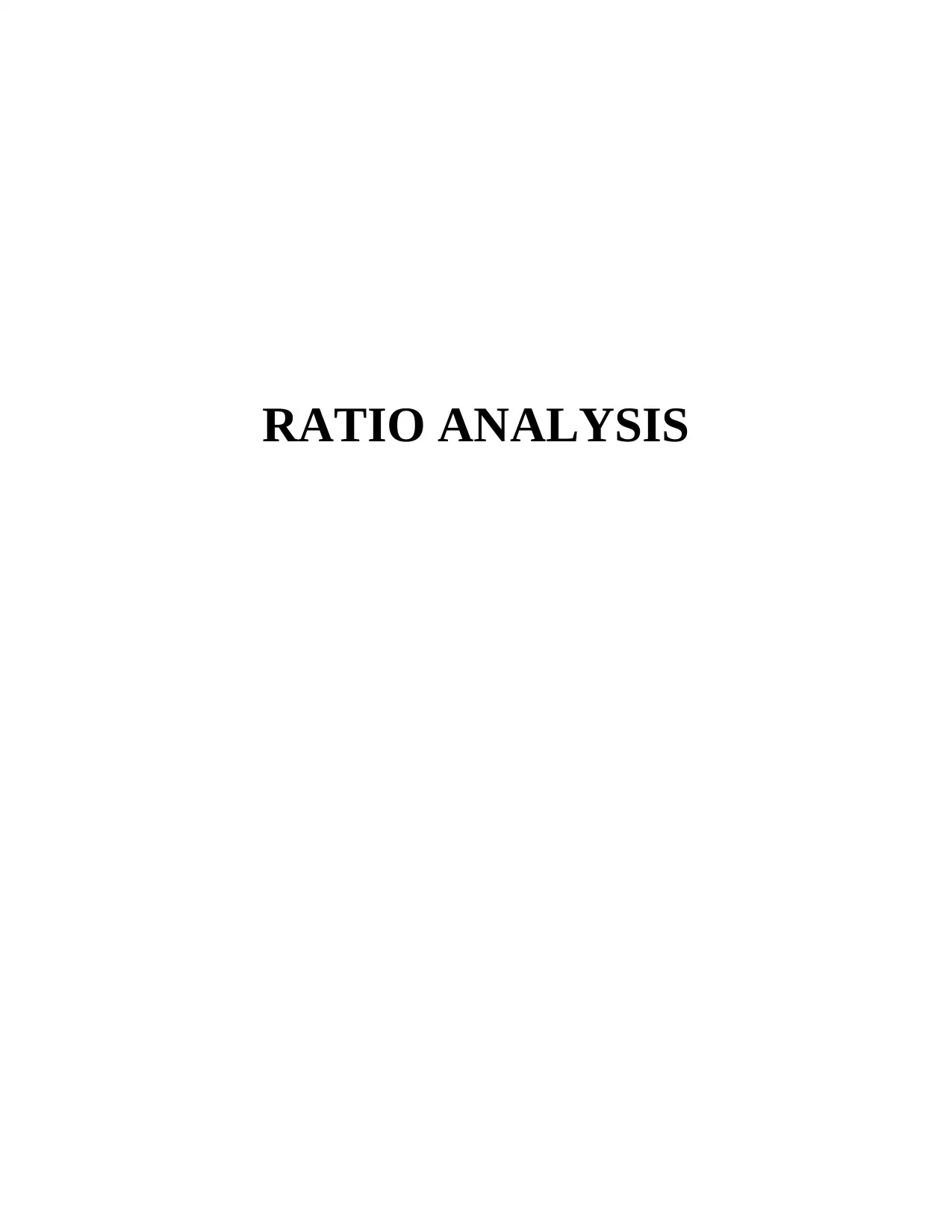
RATIO ANALYSIS
Paraphrase This Document
Need a fresh take? Get an instant paraphrase of this document with our AI Paraphraser
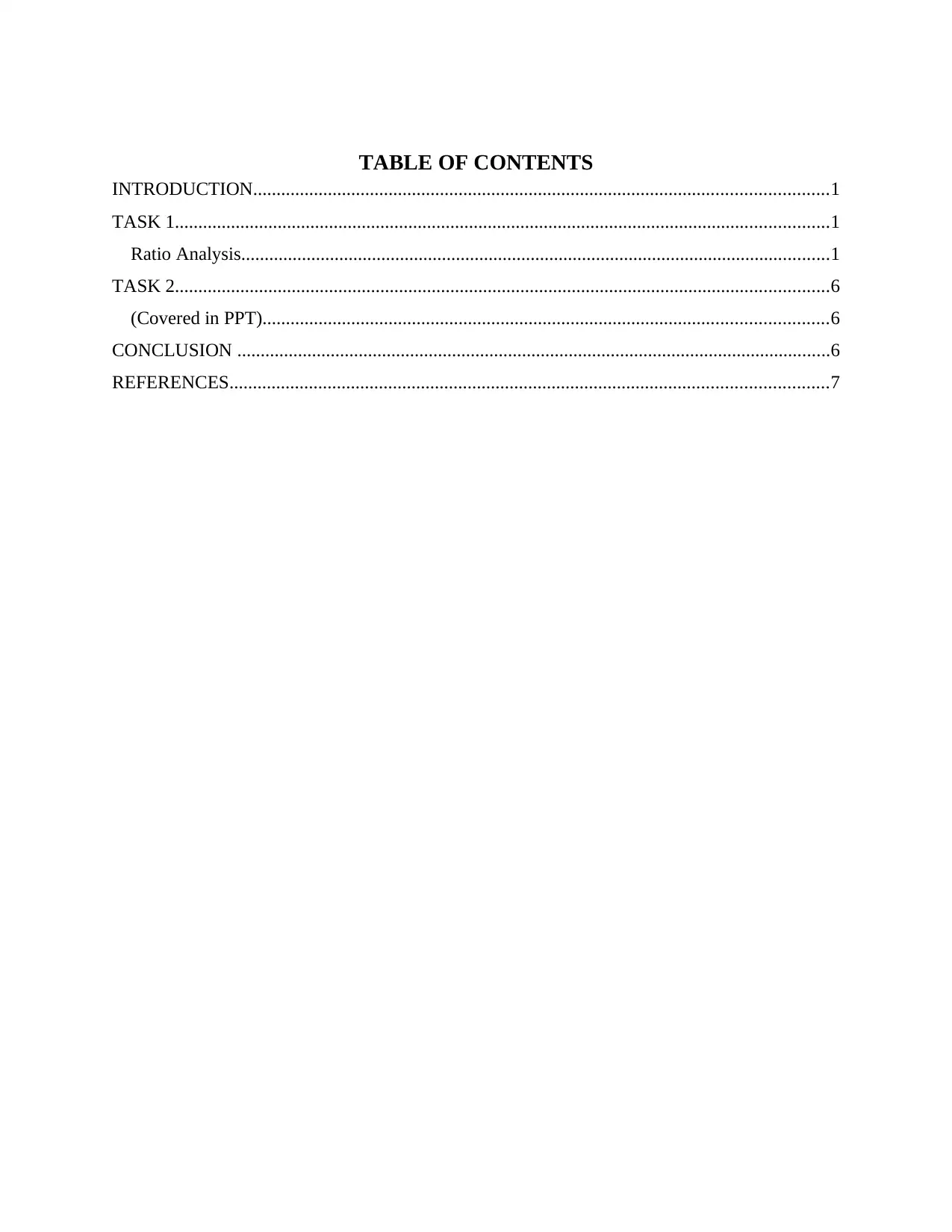
TABLE OF CONTENTS
INTRODUCTION...........................................................................................................................1
TASK 1............................................................................................................................................1
Ratio Analysis..............................................................................................................................1
TASK 2............................................................................................................................................6
(Covered in PPT).........................................................................................................................6
CONCLUSION ...............................................................................................................................6
REFERENCES................................................................................................................................7
INTRODUCTION...........................................................................................................................1
TASK 1............................................................................................................................................1
Ratio Analysis..............................................................................................................................1
TASK 2............................................................................................................................................6
(Covered in PPT).........................................................................................................................6
CONCLUSION ...............................................................................................................................6
REFERENCES................................................................................................................................7

INTRODUCTION
Financial analysis refers to evaluation of the financial performance and position of the
company. It is carried out by the experts and analysts for making decision related to the
organisation. Financial analysis of company is carried out using the ratio analysis. It is the tool
that is used for measuring the profitability, efficiency, liquidity and solvency of the firm. Present
Report will carry out financial analysis of Rangemaster plc.
Range Master PLC is manufacturing company which is engaged in supplying and
producing catering machines to restaurants, hotels and the public houses in UK. It carries out all
the trade purchases and sales on credit basis.
TASK 1
Ratio Analysis
Ratio analysis refers to comparison of the line items in financial statements of company.
It is used for evaluating the number of information of the entity like profitability, liquidity,
efficiency of the operations and capital structure of the organisation. Financial analysis is
conducted for making financial decisions of company and taking measures to improve the
financial position of the firm. It is used by investors for evaluating whether the company is
having future growth aspects analysing the performance (Durrah and et.al., 2016). Financial
analysis of the Rangemaster plc is done below.
Particulars Formula 2019 2018 Change
Profitability Ratios
Return on capital
employed
Net
operating
profit/Emp
loyed
Capital 23.08% 19.39% 19%
Employed Capital
Total
assets –
Current
liabilities
(3850-
1120) 2730 (3610-980) 2630
Net profit 630 510
Return on Equity Net
Income /
Shareholde
32.64% 31.29% 4%
1
Financial analysis refers to evaluation of the financial performance and position of the
company. It is carried out by the experts and analysts for making decision related to the
organisation. Financial analysis of company is carried out using the ratio analysis. It is the tool
that is used for measuring the profitability, efficiency, liquidity and solvency of the firm. Present
Report will carry out financial analysis of Rangemaster plc.
Range Master PLC is manufacturing company which is engaged in supplying and
producing catering machines to restaurants, hotels and the public houses in UK. It carries out all
the trade purchases and sales on credit basis.
TASK 1
Ratio Analysis
Ratio analysis refers to comparison of the line items in financial statements of company.
It is used for evaluating the number of information of the entity like profitability, liquidity,
efficiency of the operations and capital structure of the organisation. Financial analysis is
conducted for making financial decisions of company and taking measures to improve the
financial position of the firm. It is used by investors for evaluating whether the company is
having future growth aspects analysing the performance (Durrah and et.al., 2016). Financial
analysis of the Rangemaster plc is done below.
Particulars Formula 2019 2018 Change
Profitability Ratios
Return on capital
employed
Net
operating
profit/Emp
loyed
Capital 23.08% 19.39% 19%
Employed Capital
Total
assets –
Current
liabilities
(3850-
1120) 2730 (3610-980) 2630
Net profit 630 510
Return on Equity Net
Income /
Shareholde
32.64% 31.29% 4%
1
⊘ This is a preview!⊘
Do you want full access?
Subscribe today to unlock all pages.

Trusted by 1+ million students worldwide
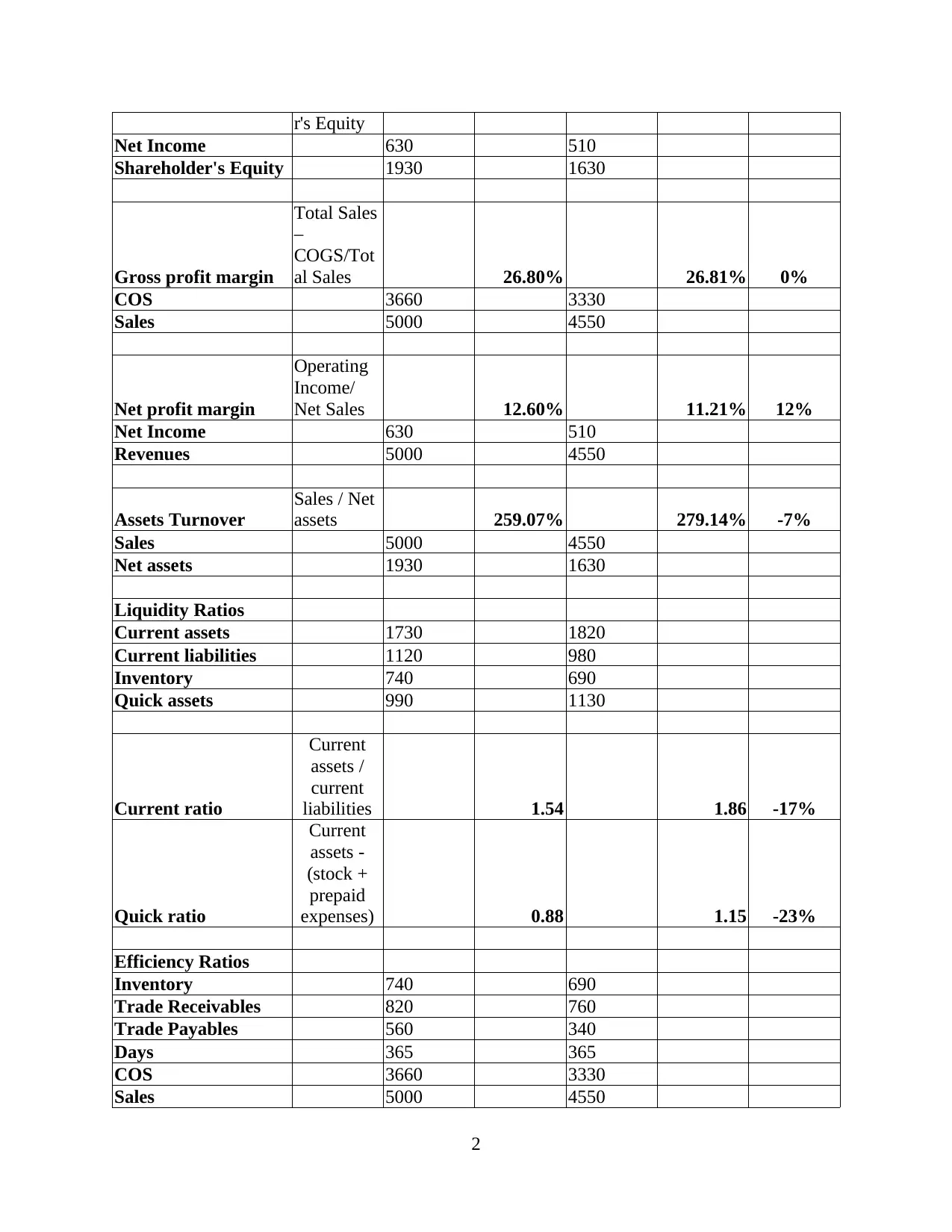
r's Equity
Net Income 630 510
Shareholder's Equity 1930 1630
Gross profit margin
Total Sales
–
COGS/Tot
al Sales 26.80% 26.81% 0%
COS 3660 3330
Sales 5000 4550
Net profit margin
Operating
Income/
Net Sales 12.60% 11.21% 12%
Net Income 630 510
Revenues 5000 4550
Assets Turnover
Sales / Net
assets 259.07% 279.14% -7%
Sales 5000 4550
Net assets 1930 1630
Liquidity Ratios
Current assets 1730 1820
Current liabilities 1120 980
Inventory 740 690
Quick assets 990 1130
Current ratio
Current
assets /
current
liabilities 1.54 1.86 -17%
Quick ratio
Current
assets -
(stock +
prepaid
expenses) 0.88 1.15 -23%
Efficiency Ratios
Inventory 740 690
Trade Receivables 820 760
Trade Payables 560 340
Days 365 365
COS 3660 3330
Sales 5000 4550
2
Net Income 630 510
Shareholder's Equity 1930 1630
Gross profit margin
Total Sales
–
COGS/Tot
al Sales 26.80% 26.81% 0%
COS 3660 3330
Sales 5000 4550
Net profit margin
Operating
Income/
Net Sales 12.60% 11.21% 12%
Net Income 630 510
Revenues 5000 4550
Assets Turnover
Sales / Net
assets 259.07% 279.14% -7%
Sales 5000 4550
Net assets 1930 1630
Liquidity Ratios
Current assets 1730 1820
Current liabilities 1120 980
Inventory 740 690
Quick assets 990 1130
Current ratio
Current
assets /
current
liabilities 1.54 1.86 -17%
Quick ratio
Current
assets -
(stock +
prepaid
expenses) 0.88 1.15 -23%
Efficiency Ratios
Inventory 740 690
Trade Receivables 820 760
Trade Payables 560 340
Days 365 365
COS 3660 3330
Sales 5000 4550
2
Paraphrase This Document
Need a fresh take? Get an instant paraphrase of this document with our AI Paraphraser
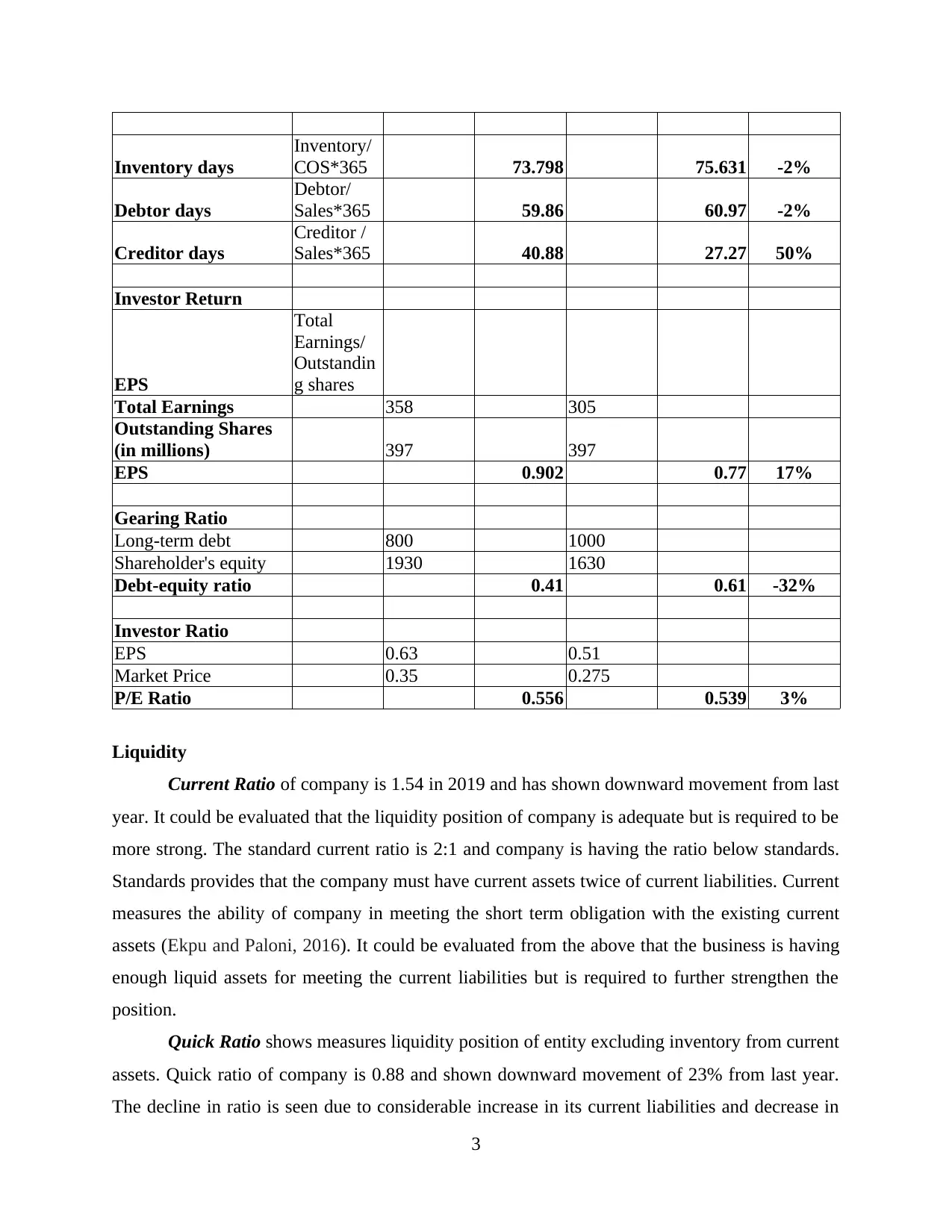
Inventory days
Inventory/
COS*365 73.798 75.631 -2%
Debtor days
Debtor/
Sales*365 59.86 60.97 -2%
Creditor days
Creditor /
Sales*365 40.88 27.27 50%
Investor Return
EPS
Total
Earnings/
Outstandin
g shares
Total Earnings 358 305
Outstanding Shares
(in millions) 397 397
EPS 0.902 0.77 17%
Gearing Ratio
Long-term debt 800 1000
Shareholder's equity 1930 1630
Debt-equity ratio 0.41 0.61 -32%
Investor Ratio
EPS 0.63 0.51
Market Price 0.35 0.275
P/E Ratio 0.556 0.539 3%
Liquidity
Current Ratio of company is 1.54 in 2019 and has shown downward movement from last
year. It could be evaluated that the liquidity position of company is adequate but is required to be
more strong. The standard current ratio is 2:1 and company is having the ratio below standards.
Standards provides that the company must have current assets twice of current liabilities. Current
measures the ability of company in meeting the short term obligation with the existing current
assets (Ekpu and Paloni, 2016). It could be evaluated from the above that the business is having
enough liquid assets for meeting the current liabilities but is required to further strengthen the
position.
Quick Ratio shows measures liquidity position of entity excluding inventory from current
assets. Quick ratio of company is 0.88 and shown downward movement of 23% from last year.
The decline in ratio is seen due to considerable increase in its current liabilities and decrease in
3
Inventory/
COS*365 73.798 75.631 -2%
Debtor days
Debtor/
Sales*365 59.86 60.97 -2%
Creditor days
Creditor /
Sales*365 40.88 27.27 50%
Investor Return
EPS
Total
Earnings/
Outstandin
g shares
Total Earnings 358 305
Outstanding Shares
(in millions) 397 397
EPS 0.902 0.77 17%
Gearing Ratio
Long-term debt 800 1000
Shareholder's equity 1930 1630
Debt-equity ratio 0.41 0.61 -32%
Investor Ratio
EPS 0.63 0.51
Market Price 0.35 0.275
P/E Ratio 0.556 0.539 3%
Liquidity
Current Ratio of company is 1.54 in 2019 and has shown downward movement from last
year. It could be evaluated that the liquidity position of company is adequate but is required to be
more strong. The standard current ratio is 2:1 and company is having the ratio below standards.
Standards provides that the company must have current assets twice of current liabilities. Current
measures the ability of company in meeting the short term obligation with the existing current
assets (Ekpu and Paloni, 2016). It could be evaluated from the above that the business is having
enough liquid assets for meeting the current liabilities but is required to further strengthen the
position.
Quick Ratio shows measures liquidity position of entity excluding inventory from current
assets. Quick ratio of company is 0.88 and shown downward movement of 23% from last year.
The decline in ratio is seen due to considerable increase in its current liabilities and decrease in
3
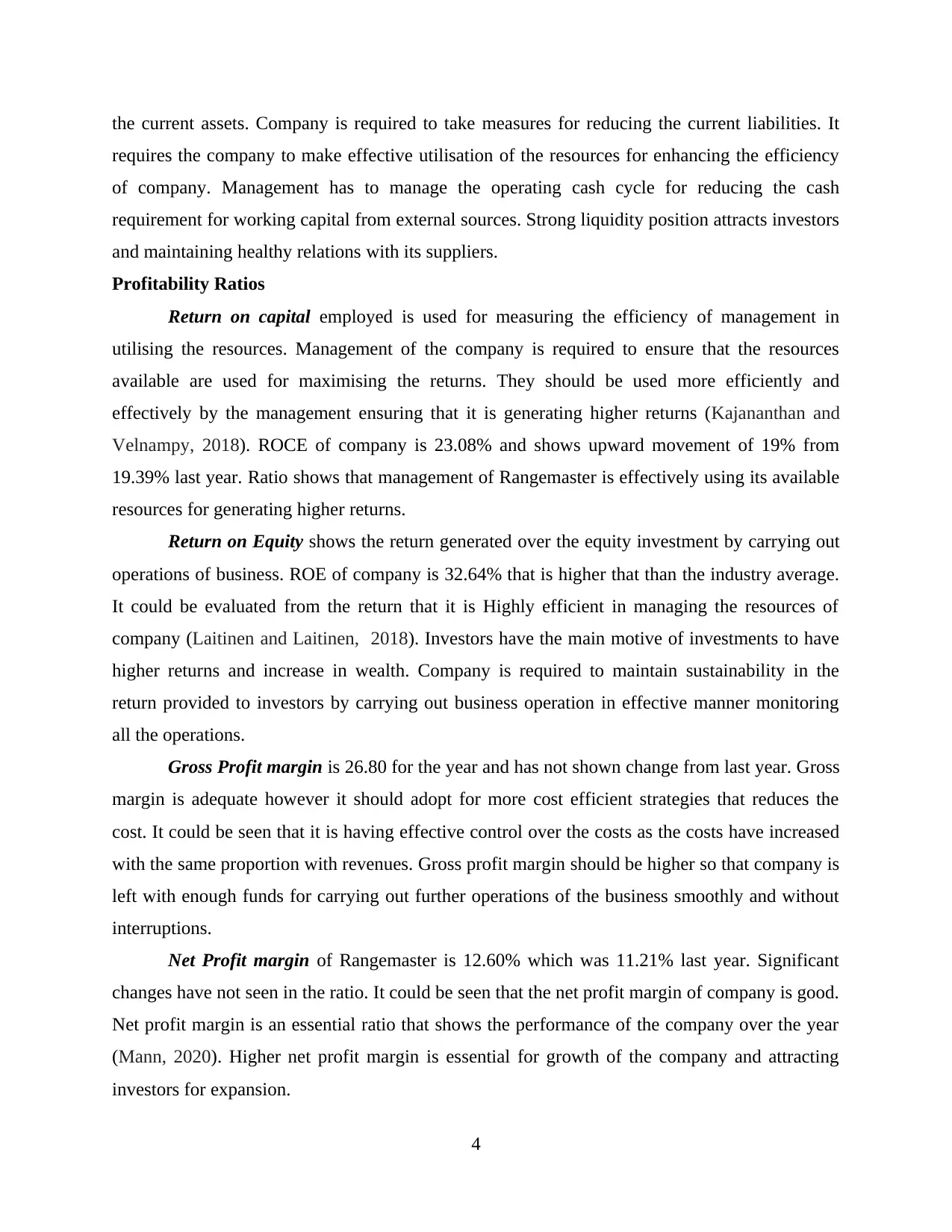
the current assets. Company is required to take measures for reducing the current liabilities. It
requires the company to make effective utilisation of the resources for enhancing the efficiency
of company. Management has to manage the operating cash cycle for reducing the cash
requirement for working capital from external sources. Strong liquidity position attracts investors
and maintaining healthy relations with its suppliers.
Profitability Ratios
Return on capital employed is used for measuring the efficiency of management in
utilising the resources. Management of the company is required to ensure that the resources
available are used for maximising the returns. They should be used more efficiently and
effectively by the management ensuring that it is generating higher returns (Kajananthan and
Velnampy, 2018). ROCE of company is 23.08% and shows upward movement of 19% from
19.39% last year. Ratio shows that management of Rangemaster is effectively using its available
resources for generating higher returns.
Return on Equity shows the return generated over the equity investment by carrying out
operations of business. ROE of company is 32.64% that is higher that than the industry average.
It could be evaluated from the return that it is Highly efficient in managing the resources of
company (Laitinen and Laitinen, 2018). Investors have the main motive of investments to have
higher returns and increase in wealth. Company is required to maintain sustainability in the
return provided to investors by carrying out business operation in effective manner monitoring
all the operations.
Gross Profit margin is 26.80 for the year and has not shown change from last year. Gross
margin is adequate however it should adopt for more cost efficient strategies that reduces the
cost. It could be seen that it is having effective control over the costs as the costs have increased
with the same proportion with revenues. Gross profit margin should be higher so that company is
left with enough funds for carrying out further operations of the business smoothly and without
interruptions.
Net Profit margin of Rangemaster is 12.60% which was 11.21% last year. Significant
changes have not seen in the ratio. It could be seen that the net profit margin of company is good.
Net profit margin is an essential ratio that shows the performance of the company over the year
(Mann, 2020). Higher net profit margin is essential for growth of the company and attracting
investors for expansion.
4
requires the company to make effective utilisation of the resources for enhancing the efficiency
of company. Management has to manage the operating cash cycle for reducing the cash
requirement for working capital from external sources. Strong liquidity position attracts investors
and maintaining healthy relations with its suppliers.
Profitability Ratios
Return on capital employed is used for measuring the efficiency of management in
utilising the resources. Management of the company is required to ensure that the resources
available are used for maximising the returns. They should be used more efficiently and
effectively by the management ensuring that it is generating higher returns (Kajananthan and
Velnampy, 2018). ROCE of company is 23.08% and shows upward movement of 19% from
19.39% last year. Ratio shows that management of Rangemaster is effectively using its available
resources for generating higher returns.
Return on Equity shows the return generated over the equity investment by carrying out
operations of business. ROE of company is 32.64% that is higher that than the industry average.
It could be evaluated from the return that it is Highly efficient in managing the resources of
company (Laitinen and Laitinen, 2018). Investors have the main motive of investments to have
higher returns and increase in wealth. Company is required to maintain sustainability in the
return provided to investors by carrying out business operation in effective manner monitoring
all the operations.
Gross Profit margin is 26.80 for the year and has not shown change from last year. Gross
margin is adequate however it should adopt for more cost efficient strategies that reduces the
cost. It could be seen that it is having effective control over the costs as the costs have increased
with the same proportion with revenues. Gross profit margin should be higher so that company is
left with enough funds for carrying out further operations of the business smoothly and without
interruptions.
Net Profit margin of Rangemaster is 12.60% which was 11.21% last year. Significant
changes have not seen in the ratio. It could be seen that the net profit margin of company is good.
Net profit margin is an essential ratio that shows the performance of the company over the year
(Mann, 2020). Higher net profit margin is essential for growth of the company and attracting
investors for expansion.
4
⊘ This is a preview!⊘
Do you want full access?
Subscribe today to unlock all pages.

Trusted by 1+ million students worldwide

Efficiency Ratio
Inventory days are calculated for measuring the efficiency of management in moving the
inventory. Rangemaster is having inventory days of 74 days that has reduced from 76 days last
year. It means company is having adequate inventory management but is required to be further
improved for generating returns.
Debtor days of company are 59.86 days. It could be evaluated that the company collects
its payments within 60 days (Martins, 2017). It is an strategy used for increasing the sales by
giving more credit to the customers. However, giving more credit days will disturb the cash
cycle.
Creditor Days is the period within which the company is making payment to its
suppliers. Company is having creditor days of 40 days with significant increase from 28 days.
Increasing the creditor days would enable the management to have effective cash cycle.
The above efficiency ratio shows the efficiency of management in operating the business
transactions. It is used for evaluating cash cycle of company which is high (Nassar, 2016.). Firm
with high cash cycle is in greater need of cash funds for meeting capital requirements.
Capital Structure
Debt equity ratio shows the capital structure of company. Debt equity ratio of
Rangemaster is 0.41 and it shows downward movement of 32% from last year. Company has
repaid some of its debt in the current year and has also issued new equity shares for raising the
capital (Setiawan, Amah and Novitasari, 2019). The capital structure of the company could be
said as optimum as it is using both debt and equity in adequate proportion keeping the cost of
capital to minimum.
Investor Ratio
Investors before investing their funds evaluates the price earning ratio of company in
which hey are planning to invest. P/E ratio of Rangemaster plc is 0.556 which is very low. This
shows that the market price of the company shares is very low. A company with lower market
price shows that it is not highly demanded in market (Rutkowska-Ziarko, 2020). Company is
required to give primary focus over increasing the PE ratios for maximising the wealth of
shareholders.
5
Inventory days are calculated for measuring the efficiency of management in moving the
inventory. Rangemaster is having inventory days of 74 days that has reduced from 76 days last
year. It means company is having adequate inventory management but is required to be further
improved for generating returns.
Debtor days of company are 59.86 days. It could be evaluated that the company collects
its payments within 60 days (Martins, 2017). It is an strategy used for increasing the sales by
giving more credit to the customers. However, giving more credit days will disturb the cash
cycle.
Creditor Days is the period within which the company is making payment to its
suppliers. Company is having creditor days of 40 days with significant increase from 28 days.
Increasing the creditor days would enable the management to have effective cash cycle.
The above efficiency ratio shows the efficiency of management in operating the business
transactions. It is used for evaluating cash cycle of company which is high (Nassar, 2016.). Firm
with high cash cycle is in greater need of cash funds for meeting capital requirements.
Capital Structure
Debt equity ratio shows the capital structure of company. Debt equity ratio of
Rangemaster is 0.41 and it shows downward movement of 32% from last year. Company has
repaid some of its debt in the current year and has also issued new equity shares for raising the
capital (Setiawan, Amah and Novitasari, 2019). The capital structure of the company could be
said as optimum as it is using both debt and equity in adequate proportion keeping the cost of
capital to minimum.
Investor Ratio
Investors before investing their funds evaluates the price earning ratio of company in
which hey are planning to invest. P/E ratio of Rangemaster plc is 0.556 which is very low. This
shows that the market price of the company shares is very low. A company with lower market
price shows that it is not highly demanded in market (Rutkowska-Ziarko, 2020). Company is
required to give primary focus over increasing the PE ratios for maximising the wealth of
shareholders.
5
Paraphrase This Document
Need a fresh take? Get an instant paraphrase of this document with our AI Paraphraser
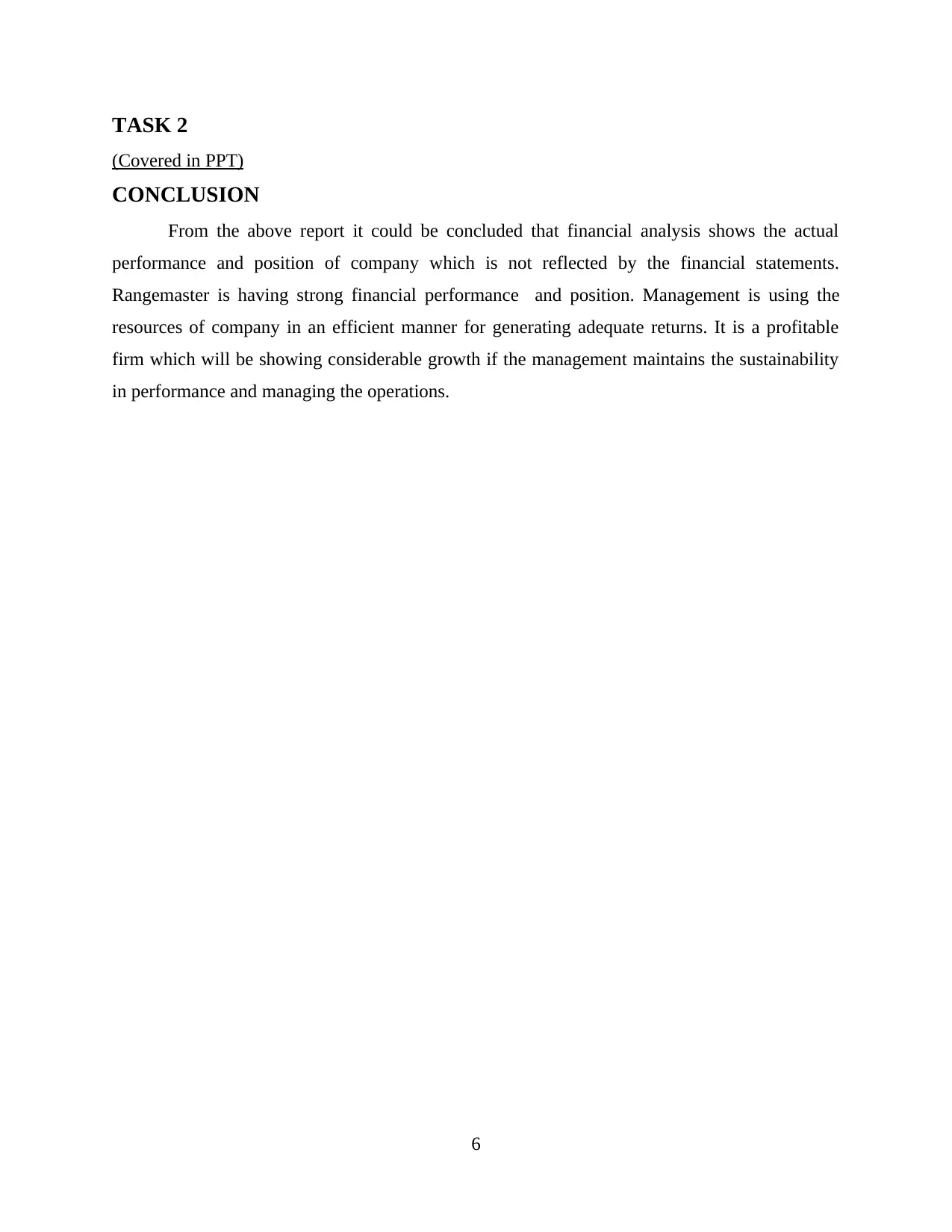
TASK 2
(Covered in PPT)
CONCLUSION
From the above report it could be concluded that financial analysis shows the actual
performance and position of company which is not reflected by the financial statements.
Rangemaster is having strong financial performance and position. Management is using the
resources of company in an efficient manner for generating adequate returns. It is a profitable
firm which will be showing considerable growth if the management maintains the sustainability
in performance and managing the operations.
6
(Covered in PPT)
CONCLUSION
From the above report it could be concluded that financial analysis shows the actual
performance and position of company which is not reflected by the financial statements.
Rangemaster is having strong financial performance and position. Management is using the
resources of company in an efficient manner for generating adequate returns. It is a profitable
firm which will be showing considerable growth if the management maintains the sustainability
in performance and managing the operations.
6
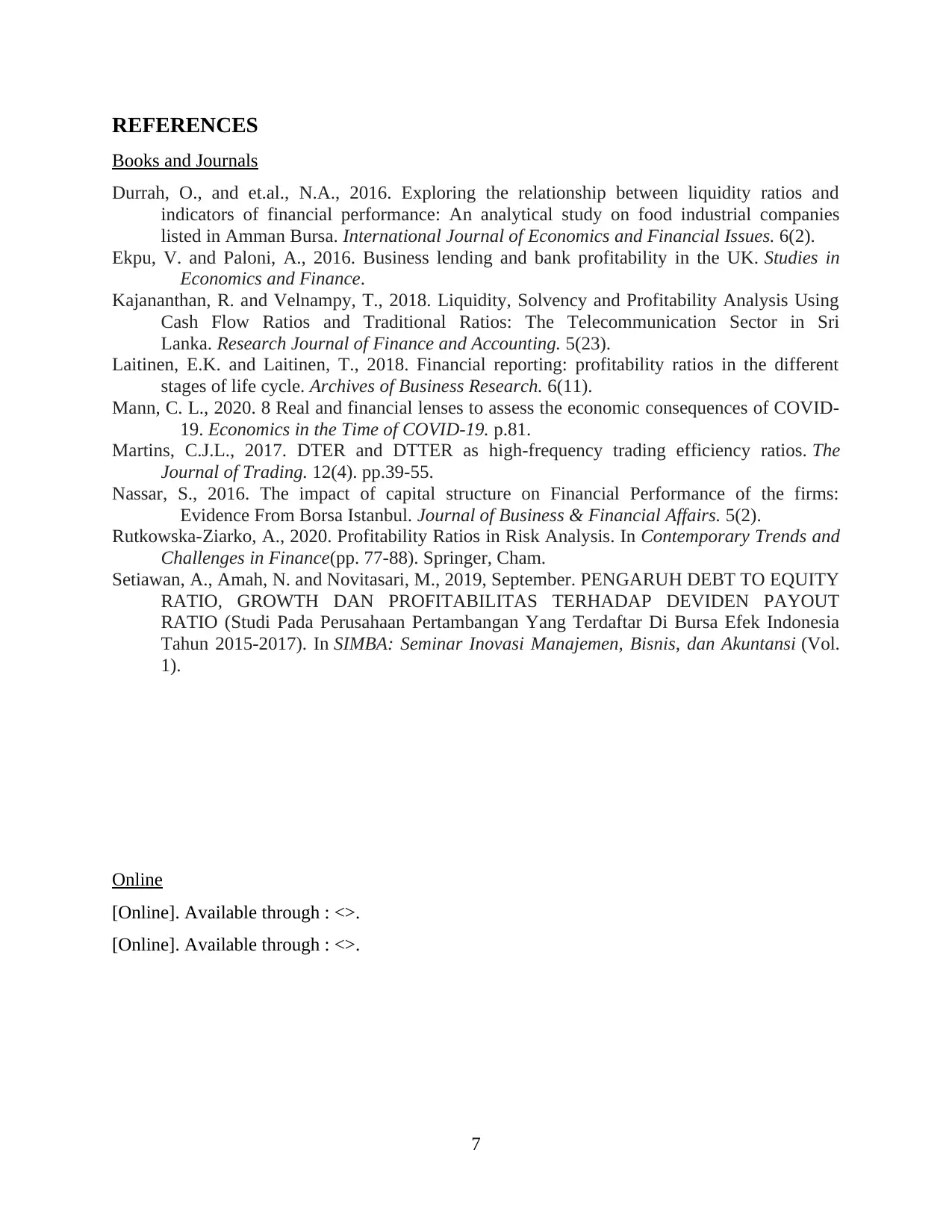
REFERENCES
Books and Journals
Durrah, O., and et.al., N.A., 2016. Exploring the relationship between liquidity ratios and
indicators of financial performance: An analytical study on food industrial companies
listed in Amman Bursa. International Journal of Economics and Financial Issues. 6(2).
Ekpu, V. and Paloni, A., 2016. Business lending and bank profitability in the UK. Studies in
Economics and Finance.
Kajananthan, R. and Velnampy, T., 2018. Liquidity, Solvency and Profitability Analysis Using
Cash Flow Ratios and Traditional Ratios: The Telecommunication Sector in Sri
Lanka. Research Journal of Finance and Accounting. 5(23).
Laitinen, E.K. and Laitinen, T., 2018. Financial reporting: profitability ratios in the different
stages of life cycle. Archives of Business Research. 6(11).
Mann, C. L., 2020. 8 Real and financial lenses to assess the economic consequences of COVID-
19. Economics in the Time of COVID-19. p.81.
Martins, C.J.L., 2017. DTER and DTTER as high-frequency trading efficiency ratios. The
Journal of Trading. 12(4). pp.39-55.
Nassar, S., 2016. The impact of capital structure on Financial Performance of the firms:
Evidence From Borsa Istanbul. Journal of Business & Financial Affairs. 5(2).
Rutkowska-Ziarko, A., 2020. Profitability Ratios in Risk Analysis. In Contemporary Trends and
Challenges in Finance(pp. 77-88). Springer, Cham.
Setiawan, A., Amah, N. and Novitasari, M., 2019, September. PENGARUH DEBT TO EQUITY
RATIO, GROWTH DAN PROFITABILITAS TERHADAP DEVIDEN PAYOUT
RATIO (Studi Pada Perusahaan Pertambangan Yang Terdaftar Di Bursa Efek Indonesia
Tahun 2015-2017). In SIMBA: Seminar Inovasi Manajemen, Bisnis, dan Akuntansi (Vol.
1).
Online
[Online]. Available through : <>.
[Online]. Available through : <>.
7
Books and Journals
Durrah, O., and et.al., N.A., 2016. Exploring the relationship between liquidity ratios and
indicators of financial performance: An analytical study on food industrial companies
listed in Amman Bursa. International Journal of Economics and Financial Issues. 6(2).
Ekpu, V. and Paloni, A., 2016. Business lending and bank profitability in the UK. Studies in
Economics and Finance.
Kajananthan, R. and Velnampy, T., 2018. Liquidity, Solvency and Profitability Analysis Using
Cash Flow Ratios and Traditional Ratios: The Telecommunication Sector in Sri
Lanka. Research Journal of Finance and Accounting. 5(23).
Laitinen, E.K. and Laitinen, T., 2018. Financial reporting: profitability ratios in the different
stages of life cycle. Archives of Business Research. 6(11).
Mann, C. L., 2020. 8 Real and financial lenses to assess the economic consequences of COVID-
19. Economics in the Time of COVID-19. p.81.
Martins, C.J.L., 2017. DTER and DTTER as high-frequency trading efficiency ratios. The
Journal of Trading. 12(4). pp.39-55.
Nassar, S., 2016. The impact of capital structure on Financial Performance of the firms:
Evidence From Borsa Istanbul. Journal of Business & Financial Affairs. 5(2).
Rutkowska-Ziarko, A., 2020. Profitability Ratios in Risk Analysis. In Contemporary Trends and
Challenges in Finance(pp. 77-88). Springer, Cham.
Setiawan, A., Amah, N. and Novitasari, M., 2019, September. PENGARUH DEBT TO EQUITY
RATIO, GROWTH DAN PROFITABILITAS TERHADAP DEVIDEN PAYOUT
RATIO (Studi Pada Perusahaan Pertambangan Yang Terdaftar Di Bursa Efek Indonesia
Tahun 2015-2017). In SIMBA: Seminar Inovasi Manajemen, Bisnis, dan Akuntansi (Vol.
1).
Online
[Online]. Available through : <>.
[Online]. Available through : <>.
7
⊘ This is a preview!⊘
Do you want full access?
Subscribe today to unlock all pages.

Trusted by 1+ million students worldwide
1 out of 9
Related Documents
Your All-in-One AI-Powered Toolkit for Academic Success.
+13062052269
info@desklib.com
Available 24*7 on WhatsApp / Email
![[object Object]](/_next/static/media/star-bottom.7253800d.svg)
Unlock your academic potential
Copyright © 2020–2025 A2Z Services. All Rights Reserved. Developed and managed by ZUCOL.





